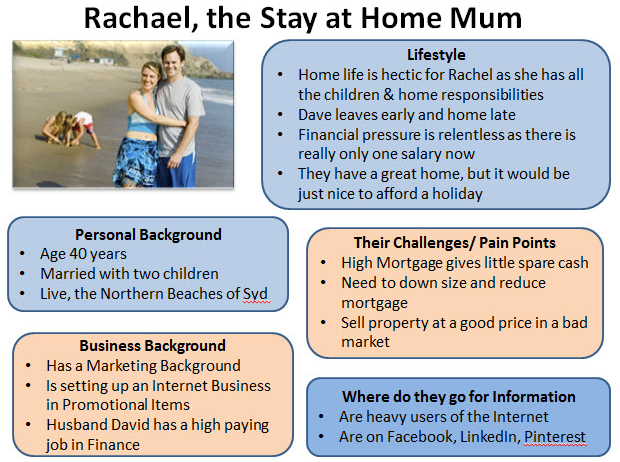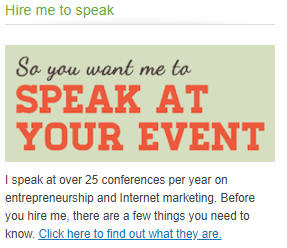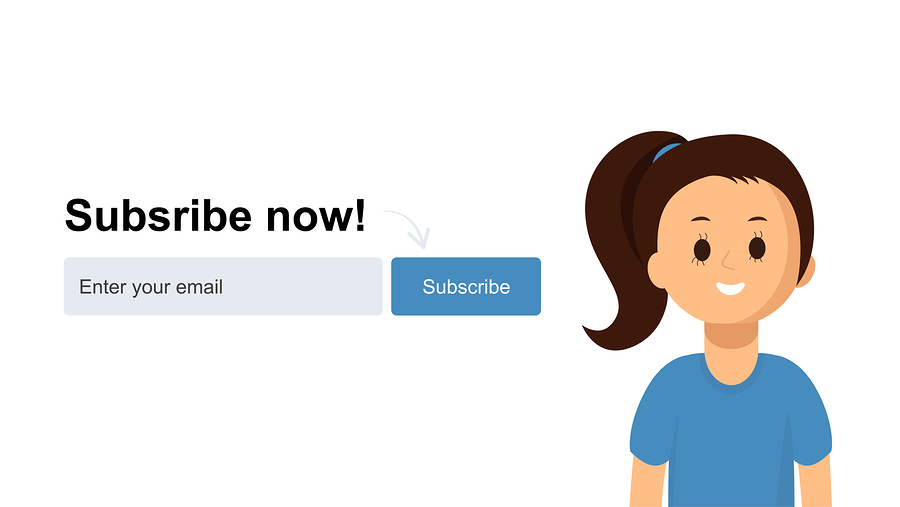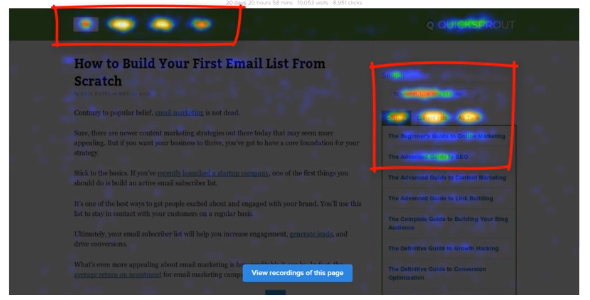According to 2018 research, the average email open rate across all industries is 32%.
But with smart planning and an effective strategy, you can grow your list and keep engagement rates even higher.
So, how do you do that? It’s easier said than done, but the following tips will help you build a high-quality email list in record time.
My email list is one of my most valuable assets. I have tons of email subscribers even though I regularly scrub my list, and I’ve converted many subscribers to paying clients.
I started in the same place as everyone else, though: zero email subscribers.
Whether your list includes 10 subscribers, 100 subscribers, or 1 million subscribers, you probably want more. That’s the nature of marketing. So, how can you increase conversions to build an email list further?
That’s the question I’m going to answer today. I’ll cover several topics, so here’s a list in case you want to skip around:
- How to Get Subscribers by Increasing Your Conversions
- How to Decide How Many Email Subscribers You Should Have
- Why Buy Email Subscribers Isn’t a Good Idea
- How Crazy Egg Tools Can Help You Improve Your Email List
How to Get More Email Subscribers By Increasing your Conversions

“Conversion” can mean a lot of different things:
- Email subscription
- Requests for sales calls
- Purchases
- Free demo trials
For this article, I’m going to focus on email conversions. You’re collecting leads by inviting people to sign up for your email list.
In most cases, you’ll use a lead magnet or some other incentive to increase email subscribers. A lead magnet can be anything — discount code, free shipping offer, ebook, toolkit, calculator — that your prospect will find valuable.
I’ll cover lead magnets in more detail later, but for now, start brainstorming potential magnets. Think about your audience, product, and business model for reference, then decide what your visitors might find most appealing.
To get more email subscribers, you need an optimized conversion funnel. It might start with a lead magnet, but how you present the magnet will impact conversions. Consequently, you need a more holistic approach than building a lead magnet and hoping people will sign up.
Let’s look at some of the most effective ways to increase your conversions and get more email subscribers fast.
1. Characterize your potential email subscriber
You’ll get more email subscribers if you know your audience well. Develop a buyer persona for each “character” who might be interested in your products or services.

Each buyer persona represents a member of your target audience. You might have just one or two personas, while other businesses might have 10 or more.
For instance, let’s say that you have an e-commerce store where you sell sporting goods. A teenage customer playing high school sports would be a different persona from a middle-aged man who plays pickup basketball on the weekends.
More importantly, you would market to those people differently. Each buyer persona will respond to different products, offers, and messaging.
2. Figure out how your users are navigating your website
You can learn a lot about your website visitors by checking out reports in Google Analytics. A traffic report will show you the sources for all your traffic and what percentage of your total traffic each referral source represents.

Based on this data, you can optimize popular pages with compelling lead capture forms and CTAs. You might also offer a different lead magnet based on the individual page’s content.
Maybe your most popular blog post is a primer on landscape photography. It’s been widely shared on social and gets tons of organic traffic.
You know you’re attracting beginner shutterbugs based on the page content, so you create a lead magnet for beginners who are interested in photography.
You might also use heatmaps on your website to figure out where the clicking activity takes place. Use that information to decide where to put critical elements that result in more email subscribers, such as calls to action for your newsletter.

Once you have a better picture of the flow of traffic through your website, you can optimize key pages for conversions.
For instance, you might learn that the most activity occurs above the fold on your web pages. You’ll know that users don’t like to scroll, so you’ll need to include your email CTA as close to the top of the page as possible.
If nobody’s interacting with your email CTA, maybe you need to make it more distinctive. Test different colors, imagery, and CTA text.
3. Don’t confuse your readers with web forms
Web forms need to be intuitive and easy to fill out. Otherwise, your website visitors won’t bother to fill them out.
Often, marketers unintentionally confuse their readers. For instance, using CAPTCHA to verify human traffic on your site might seem like a good thing, but what if the CAPTCHA is impossible — or even just difficult — to discern?

Additionally, be very clear about why your users are filling out the form. You want more email subscribers, so you’re offering an incentive. Tell your readers in clear language what they can expect.
Let’s say you’re offering a whitepaper as a lead magnet. Tell the reader how the paper will be delivered (e.g. a link on the next screen, a download in an email, etc.). That way, there are no miscommunications.
The new GDPR rules can also be confusing. You have to ask your subscribers whether they want to hear from you apart from your lead magnet. In this video, I explain how GDPR can impact your business and email collection practices.
4. Offer unique lead magnets
A lead magnet should offer so much value that your target customer can’t resist it. Don’t throw something together in 10 minutes and hope it works.
Start with the buyer personas I talked about earlier. Ideally, you’ll have a lead magnet for each of them.
We’ll go back to my sporting goods e-commerce store example. What kind of lead magnet might your prospects want?
- A teenage basketball player might want a guide to the hottest basketball shoes.
- Middle-aged men who run on the weekends might want a guide to optimum pulse and respiration during cardiovascular exercise.
- Young mothers who want to stay fit could benefit from an illustrated list of quick exercises.
A lead magnet shouldn’t be something you want to create. It should be something your prospect wants to get his or her hands on right now.
Survey other businesses in your industry or niche. Visit their websites and write down the types of lead magnets they offer. You want to create something entirely unique.
5. Optimize your landing pages

Visitors can wind up on your landing pages for a variety of reasons. They might click on an email link, Facebook post, or paid search ad.
The landing page needs to align with the referral source in design and content. For instance, if your Facebook post promises a free calculator download, your landing page better offer the same thing.
Try to mimic the look in both style and function. Using similar colors and shapes will help with recognition and reassure the visitor that he or she is on the right page.
Did you know that companies with 15 or more landing pages get 55 percent more leads than those with 10 or fewer landing pages? Many businesses build just one landing page and assume it will cover all the bases. That’s far from the truth.
To see how your landing pages perform, track various metrics over time. Click-through rates tell you how many people acted on the CTA on your landing page. You can track that data with Google Analytics.
For long-form landing pages, run a scroll map report. You’ll see where visitors lose interest or decide to sign up.

Heat maps and confetti maps can also prove useful. You want to see exactly how people behave on your site so you can deliver what they expect or need. To see an example of all these user behavior reports in action, you can experiment with this demo page.
After you’ve collected sufficient data and have an idea of what changes you would like to make to your site to increase email signups, you can start A/B testing your landing pages so you know which versions of each test produce more email subscribers.
6. Try an exit popup
Another way to boost your number of email subscribers by improving your signup conversion rate is to create an exit popup.The popup only appears when someone tries to leave your website.
You can use the “Create Email” goal and ask people to sign up for your newsletter or you can promote a specific product. When someone buys from you, you collect his or her email address, which results in more subscribers.
Just make sure you use a tick box so customers agree to hear from you for promotional purposes. Stress your lead magnet or other subscription benefits.
You’ve probably seen thousands of exit popups. Here’s an example from Hello Bar:

You can design your exit popup however you want, but it needs to grab your visitors’ attention. As Hello Bar reveals, 98 percent of your visitors will leave your site without doing anything at all. An exit popup gives visitors another chance to convert.
Try using appealing images, rounded CTA buttons, and contrasting colors to garner more attention. You can also ask leading questions to guide your visitor into a conversation in the popup. At the end, present your CTA for an email signup.
Use the CTA button to take visitors to your signup form. If you’re offering a lead magnet, ensure you mention it on the popup.
7. Know how to use your posts with highest traffic
Your blog can become an amazing tool for getting more email subscribers if you know how to use it. Each post creates a new opportunity to convert a consumer.
Blog posts are generally the longest, most SEO-optimized pages on a website. They have lots of text and valuable information — when written correctly — so they attract organic traffic.
At Quicksprout, for instance, we’ve optimized our blog posts to include sidebar CTAs at the exact right spot based on scroll and heat maps.

We’ve used that space to collect email addresses before, but now it’s a CTA for getting me to speak at your event.

We do something similar on the Crazy Egg blog.

And you’ll see a similar CTA at the ends of our blog posts.

Even if you don’t want to add subscribe forms to every post on your website, optimize your top-performing blog posts. Check Google Analytics to make sure you know your stats, then determine where your CTA should go.
8. Add social proof to build trust
Social proof has become increasingly important, especially in an age when people don’t like giving out their contact information. There are several forms of social proof:
- Written, spoken, or video testimonials
- Logos of brands you’ve worked with
- Numbers (e.g. “Join 30,000 other subscribers…)
- Quotes from experts and thought leaders
- Reviews from satisfied customers
You don’t have to include it all on your landing pages and near your CTAs, but incorporating one or two types of social proof can help boost conversions. You’ll get more email subscribers because people feel more comfortable now that they know your reputation.
Writing for Instapage, Marcus Johnson says, “The power of social proof is undeniable, and it could be the key to optimizing your next marketing campaign.” He cites Wrike as an excellent example of social proof on a landing page.

You could just as easily incorporate a quote from a satisfied customer or display your average Yelp review. It all depends on what type of social proof will most impact your audience. A/B testing can help identify the best forms of social proof for your site.
How to Decide How Many Email Subscribers You Need

How many subscribers do you need? Enough to reach your business goals. In other words, you want to build up as many leads as possible so you have the opportunity to sell more products.
Let’s say you have 100,000 subscribers and an email click-through rate of 5 percent. This means your emails go out to 100,000 people, and 5 percent of them click on your CTA in those emails.
We’ll go on to say that your website has a conversion rate of 2 percent. This means that 5,000 people will click on your email CTA, and 100 of them will buy your product. If your product costs $100, you’ll generate $10,000 in revenue.
This is a simplistic breakdown, but you get the point.
Crunch numbers to figure out what goal you should set for email subscribers. However, remember that you can never have enough. You’ll have to scrub your email list from time to time, which means removing inactive email addresses, to protect your reputation. Email collection will continue through the life of your business until email becomes obsolete.
Why Buying Email Subscribers Isn’t a Good Idea
You should never buy email subscribers. That’s like paying 100 people $10 each to walk into your brick-and-mortar store. They’re going in for the money — not the merchandise. How many do you think will actually buy something?
Buying email subscribers results in a highly unqualified list. Worse, the people on that list don’t really want to hear from you because they never actually signed up for your emails.
“But what if some of them end up buying from me?” you ask. Well, it can happen. But it’s not worth the cost.
When you buy email subscribers, you’re more likely to get on email clients’ blacklists. Gmail and other clients might send your emails to the promotions tab, but they’re more likely to send them straight to spam.
This is because the people who know they didn’t sign up to receive your emails will send your messages to spam. Email clients track this activity and mark your email address as a spammer.
You’ll also get an inflated impression of your total leads. The number of qualified leads diminishes quickly when you’re buying email addresses.
How Crazy Egg Tools Can Help You Improve Your Email List
Crazy Egg is a set of conversion rate optimization tools. You can use it to get more email subscribers by optimizing your site for conversions.
Let’s say, for instance, that you don’t know where to put your email signup link or form. Use a heatmap to figure out the areas where website visitors click the most. That will tell you where their attention goes upon arriving on your site so you can set up your email form strategically.

After you’ve run heat maps and other reports, use the data to A/B test your website pages. You can change any element you wish for each test, from colors and fonts to offers and headlines. The more you test, the more refined your email collection process becomes.
1. Craft a more compelling offer
We’ll start off with the biggest and most important element to increase your subscribers—make the offer more appealing.
Sure, you can tweak button colors and improve small factors on your conversion rate. But if you don’t have an offer that converts, you’re being penny-wise and pound foolish.
Instead, focus on what you’re offering prospects in exchange for their email address. Today, we guard our email address carefully. We’ve seen too many companies spam us.
So understand what it is your target customer really wants, and give it to him or her.
I recommend testing a few different offers and seeing which ones perform best.
Who knows?
The crazy idea you never thought would convert emails subscribers might be the best opt-in you’ve ever run. You’ll never know until you start experimenting.
2. Make it as easy as possible to enter an email address
There’s a debate in marketing circles about requiring the first name on an email form, or just asking for the email address.
The argument for the first name is that it can help with personalization later on.
But the reasoning behind just the email address is also compelling—the simpler your opt-in form, the more likely someone is to subscribe.
By removing the name field, you’ll grow your email list faster. If you want speed, consider removing everything except the email address.
In fact, every step you can take to make the form simpler will help you build your audience. The fewer steps between a consumer being interested and them subscribing helps you grow.
3. Encourage people to forward your newsletter
It might seem outdated, but why not?
In an email that you expect will get a particularly strong reaction, you can encourage your subscribers to forward an email.
But if you’re going to use this method, you need to have a few things in place. First, make sure you have a way for new people to sign up.
And second, ensure the people who get the forwarded email don’t click the unsubscribe button—they’ll be removing the original recipient from the list, not themselves.
As long as you can include details on both of those factors in the email, asking your loyal existing subscribers to forward the email can be a great way to find like-minded prospects.
4. Minimize the clicks it takes to subscribe
Most people have their opt-in form placed on the front page of their site, which is great. The home page is the perfect place for an opt-in.
But what happens if people land on other pages?
Oftentimes, website owners only include opt-ins in the footer of common pages, like blog articles. Or worse, subscribing boxes aren’t even available on these pages.
Don’t make the same mistake. Include a place to sign up for your email list across your site, on every page. Include your top-performing offer and don’t be afraid to ask for the subscription.
5. Consider using QR codes
Sometimes, the secret to marketing strategies that work is breaking out of the box. In the case of email subscriptions, the secret might be getting out of the digital world.
Quick Response, or QR, codes are a simple way to encourage people to sign up for an email list even when they’re not online.
These simple patterns are like square barcodes. If you haven’t used one before, you can scan them with your phone and it will automatically pull up a web page.
To make the best use of a QR code, place them in the physical world, like on a product or sticker or sign. Include the basics of the offer next to the code.
Then, when someone scans the code, take them to a mobile-friendly version of your signup form. (It’s important it’s mobile-ready, since people scan QR codes with their phones.)
It’s a unique method of advertising your email list that can work wonders for the right type of niche.
6. Engage new subscribers immediately with your thank-you page
The thank-you page, or confirmation page after a subscriber signs up for your email list, is one of the most underrated places to grow your email list.
There are two ways you can do this. First, you can offer a special discount or tempting offer to the subscriber.
For example, a one-time 50% discount could immediately turn many subscribers into buyers—making them instantly more valuable to your business.
You can also provide something free, in addition to the offer you already promised, that keeps subscribers surprised and on the lookout for more great things from you.
But to take it to the next level, you can also use your confirmation page as a subscriber-generating page. You can create a referral campaign and offer great things to people who get someone else to subscribe.
Alternatively, you can offer additional bonus content but require the new subscriber to share on Facebook or Twitter to unlock it.
There are plenty of tools that can do this very thing for you, like the referral setup with Kickoff Labs.
7. Give the user more control over the content
Part of the factor in the growth of an email list is making sure people don’t unsubscribe.
If you’re getting an increase in unsubscribes, it might not be because people are uninterested. It could just be that they’re overwhelmed.
For someone who simply can’t keep up with all the emails you’re sending, the solution isn’t to force them to unsubscribe. Instead, offer a “light” subscription, or perhaps different plans.
You could offer the standard subscriptions with a few emails a week, a digest email with just one email per week, and a monthly review that summarizes everything in fewer messages.
The idea is to keep subscribers on your list, even if they aren’t receiving the full volume of your emails.
It’s better to have an engaged subscriber with little volume than a subscriber who gets every email, but never reads them.
8. Invite subscribers through your social networks
Email marketing is far from dead, but lots of people today prefer to communicate on social networks. Why not reach out to those people?
You can invite people following you on Facebook and Twitter to join your email newsletter. The best way to do this is to create a landing page specifically for those followers.
Then post or tweet the link to the signup page. Since every email subscriber is worth money, that’s a message that would make sense for paid promotion if you can reach more followers and fans.
9. Craft your subject lines like Tweets
If you want your messages to really stand out in the inbox, you can use Twitter-like shortcodes and emojis.
This type of subject line stands apart from the stream of other emails in a subscriber’s inbox and keeps those subscribers engaged.
Again, an engaged subscriber is more likely to purchase from you, recommend a friend, or stay active and not unsubscribe.
Keeping your existing subscribers happy is a key part of growing your email list.
10. Maximize the email preview
In the early days of email, all you could see was the subject line.
Today, however, email clients like Outlook and Gmail show snippets of the email in a small preview line after the subject.
This is valuable screen real estate, and you should do your best to maximize that space. How can you do it?
Well, there are basically two ways. First, you can simply make the first sentence of your email catchy.
The second option is to include a hidden piece of text beforehand. This preview text shows up in the preview window on these programs but doesn’t appear in the body of the email.
This strategy can improve your email open rates, thus keeping more subscribers around for the long-term—and making them more likely to buy.
Conclusion
Getting more email subscribers requires an optimized conversion process. You have to give website visitors a reason to convert on your offer, whether it’s a lead magnet or a discount.
Incentivizing conversions will help you collect more email addresses. The more, the better. Set a goal for email collection by figuring out how many emails you need to reach your revenue targets for a given time period.
For reference, here is a checklist of my eight tips for getting more email subscribers:
- Characterize your potential email subscribers
- Figure out how your users are navigating your website
- Don’t confuse your readers with complicated web forms
- Offer unique lead magnets
- Optimize your landing pages
- Try an exit popup
- Know how to use your posts with the highest traffic
- Add social proof to build trust
It’s never a good idea to buy email subscribers. It might seem like an effective shortcut, but it can harm your reputation and leave you with very few sales.
Instead, use Crazy Egg tools to figure out how to optimize your conversion funnel and learn how to gain subscribers fast. Where should your signup forms go? How should you format your landing pages? Heat maps, scroll maps, and other reports can show you where the best opportunities lie.
Implement my nine tips on getting more email subscribers so you can boost your sales and keep your business profitable for years to come.

Add a Comment